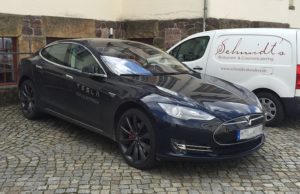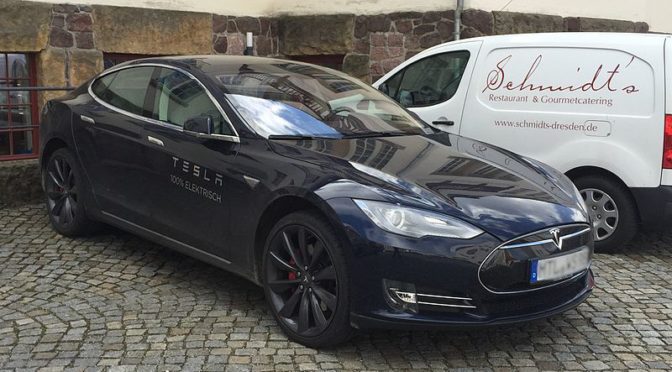The Tesla Model S is the most popular large electric vehicle sold in the United States and around the world, and as of 2018 continues to be the longest-range mass production electric vehicle money can buy. Aside from its gasoline-free properties, it competes in the large luxury car sphere, drawing fire from luminaries like the Mercedes-Benz S-Class and E-Class, the Audi A8 and A6, the BMW 7-Series and 5-Series, and the Volvo S90. Price-wise, it keeps up, and its safety features are certainly close enough to keep it in competition. But how does it compare to the competition in the all-important task of keeping your little ones safely restrained? I made it my task to find out.
Regardless of what you’re driving, everything starts with rear-facing when it comes to car seat safety. Whether you’re 8 hours old or 80 years young, you’re best off rear-facing. Practically speaking, if you can keep your little ones rear-facing until at least 4, the way the Swedes do, you’re on the right track. At that point, if you wish, you can switch to forward-facing. To be honest, you can keep rear-facing too, but if you forward-face, know that you can also switch directly from rear-facing into boostering if your children are ready. From then on, you’ll want to keep your kids in high-back boosters until they’re ready to use adult seat belts; this typically won’t happen until they’re at least 10 to 12. It’s not a race; keep kids in earlier stages if possible for as long as possible.
It’s important to note that the Model S, unlike nearly any other car currently sold in the United States (save the wagon version of the E-Class) actually seats seven, not five. It optionally includes a pair of rear-facing harnessed seats that allow you to fit a pair of children (not adults) in a 3rd row. However, keep in mind that the kids must be at least 37 inches (940 mm) tall while weighing at least 35 but no more than 77 pounds. The seats effectively function as a pair of rear-facing convertible seats for preschool-to elementary-aged children that can’t be turned forward-facing.
The guide below represents only a fraction of available combinations for the Model S; if you find other combinations that work, feel free to let me know through the forums; I’ll add more seats as I get the chance to test them.
You can access the complete 3 across guide for every vehicle here and the complete list of recommended seats here. The Canadian car seat guide is here. 3 across car seat images are courtesy of Wikipedia or the NHTSA.
2016-2019 Tesla Model S (WhiteStar)
 Guaranteed 3 across installations:
Guaranteed 3 across installations:
Clek Fllo (x3).
Clek Foonf (x3).
Clek Oobr (x3).
Maxi-Cosi RodiFix (x3).
Peg Perego Flex 120 (x3).
Diono Radian R120 (x3).
Diono Radian RXT (x3).
Diono Radian R100 (x3).
Chicco KeyFit 30 (x3).
Graco Size4Me 65 (x3).
Graco Contender (x3).
Combi Coccoro (x3).
Clek Fllo, Diono Radian / RXT, Diono Radian / RXT.
Clek Fllo,Graco Size4Me 65, Graco Size4Me 65.
Clek Fllo, Graco Size4Me 65, Diono Radian / RXT.
Tips and Tricks:
The initial generation of the Tesla Model S fastback sedan is just under 196 inches long and just over 77 inches wide with a height of 57 inches and a wheelbase of 117 inches. In other words, you’re going to be able to fit most car seats inside without much trouble as long as you’re willing to use seat belts instead of LATCH for the wider ones. Remember that there’s no safety difference between seat belts and LATCH, but seat belts are much more efficient in helping you squeeze out every available inch of space in your back seats. The center seat is the narrowest and is where you’ll want to install the narrowest seat.
It’s important to note that the optional rear-facing seats can’t be used with separate car seats; they are the car seats. However, they can only be used with children between 35 and 77 pounds who are at least 37 inches tall; the effective height limit is around 45 inches due to the slope of the rear windshield. As a result, it’s best to see these additional seats as seats for preschoolers, kindergartners, and perhaps first graders; larger children are unlikely to fit due to height restrictions even if they fit the weight limits.
 If you find my information on best practices in car and car seat safety helpful, you can buy my books here or do your shopping through this Amazon link. Canadians can shop here for Canadian purchases. Have a question or want to discuss best practices? Send me an email at carcrashdetective [at] gmail [dot] com.
If you find my information on best practices in car and car seat safety helpful, you can buy my books here or do your shopping through this Amazon link. Canadians can shop here for Canadian purchases. Have a question or want to discuss best practices? Send me an email at carcrashdetective [at] gmail [dot] com.

